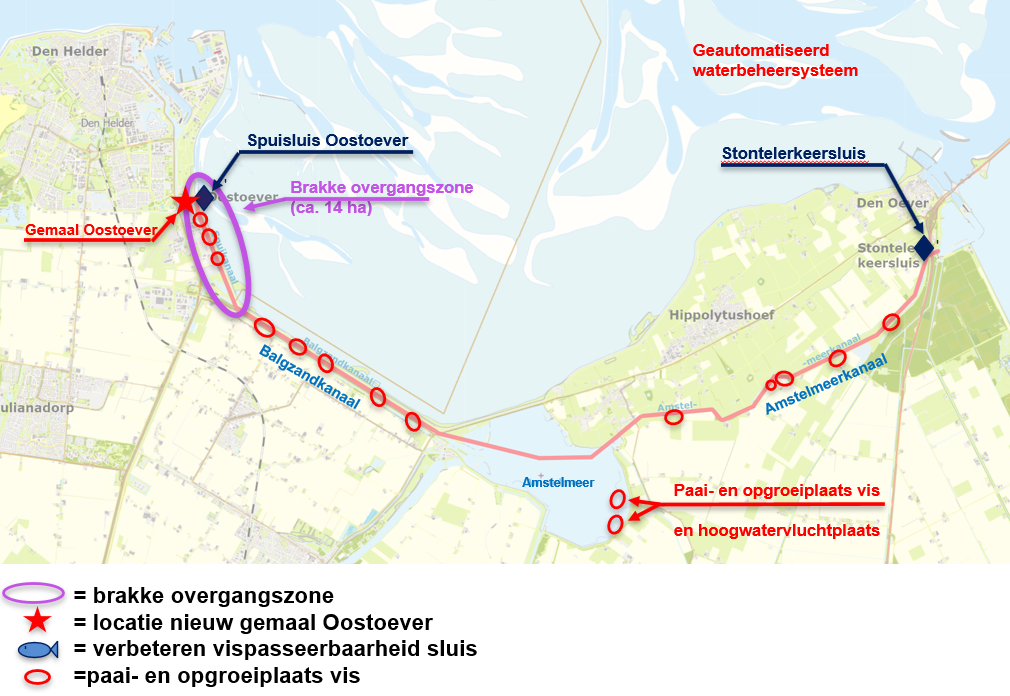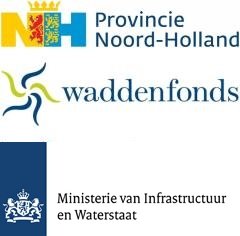Improving wet infrastructure North Head
This project (Noordkop for short) will improve fish migration and diversity of fish species between the Wadden Sea, the IJsselmeer and the North Holland hinterland that lies in between. It also leads to more diverse habitats for fish.
The Noordkop project focuses on the Amstelmeer estuary between the Spuisluis Oostoever near Den Helder and the Stontelerkeersluis near the IJsselmeer. The measures we are taking not only improve fish migration and diversity but also contribute to a future-proof water management system. In other words, the measures will help to properly regulate the increasing amount of water in the area in the years to come. A future-proof water management system is very important for future water safety.
What will happen?
Along the Wadden coast, the transition from salt to fresh water to the hinterland is quite abrupt. A gradual transition is important for many fish species. This concerns partly fish that migrate between the Wadden Sea and the IJsselmeer and partly fish that thrive better in brackish water (a combination of fresh and salt). In the Noordkop project we are solving this by creating a ca 14 ha brackish transition zone in the Spuikanaal near Oostoever. This is only possible if we can properly control the amount of incoming salt water. Among other things, too much salt water has a negative effect on agriculture, which depends on fresh water.
We control this in a number of ways:
- The current Spuicomplex allows us to drain saltwater
- With the pumping station to be built at East Bank, we can drain saltwater at high tide
- The Stontelerkeersluis inlet allows us to supply fresh water from the IJsselmeer
- With the natural threshold at the Balgzand Bridge, we prevent salt water from adversely affecting the freshwater basin of the Amstel Lake.
All this is regulated through an automated water management system. This allows salt to be allowed in the westernmost part of the Amstel Lake basin while at the same time maintaining the fresh water supply for agriculture.
In addition, we are making it easier for fish to pass at pumping station Oostoever and the Stontelerkeersluis by constructing two fish passages. We are also constructing spawning and nursery areas in the Amstelmeerboezem for fish and high-water refuge areas in the Amstelmeer for birds.
Through this page, we will keep you updated on developments regarding the components of this project:
- East Bank Pumping Station
- Fish passages (East Bank and Stonteler lock).
- Fish spawning and rearing sites
- Automatic water management system
- Fish Monitoring

Realization of fish spawning and rearing sites.
From August 2025, the firm Beentjes GWW started constructing fish spawning and rearing areas in the Amstelmeerboezem. The work will take place in the reed banks of the Spuikanaal, Balgzandkanaal, Amstelmeerkanaal and the forebay near the Stontelerkeersluis.
The work consists mainly of the excavation of silted banks and the installation of pile bulkhead shoring. Most of the locations will be realized from pontoons in the water. This creates lee zones: pools of varying depths that protect young fish from leaching and serve as resting and spawning areas for all fish.
A total of 2.15 hectares of fish spawning and rearing areas will be created, spread over a length of 16.5 kilometers. Work is expected to be completed by spring 2026.
Webinar
On June 24, 2024, we hosted an informative webinar on the project.
The questions that were most frequently asked during the webinar and their answers can be found on the Frequently Asked Questions Webinar North Head page.
Are you curious about what fish migration looks like? We explain it below in a short animation.
Improving fish migration
Two types of fish benefit from the measures. The so-called tidal migrants: these are fish that use rising tides to enter the polder. And the migratory fish species that need a gradual fresh-salt transition to acclimatize. Examples are glass eels and three-spined sticklebacks. The brackish transition zone is also important for fish species that live year-round in the brackish transition zone. Precisely these three groups are almost completely absent at present, but are important because the survival of these fish is seriously threatened. The area functions as a habitat and a passageway between the Wadden Sea, the North Holland hinterland and the IJsselmeer. The measures also improve accessibility from the IJsselmeer to the Amstelmeer estuary and the hinterland, and vice versa.
Future-proofing Amstelmeer basin and Oostoever pumping station
The package of measures is an investment to improve fish migration. An additional effect is that we increase the future resilience of the Amstelmeerboezem. In the current situation the Amstelmeer basin drains into the Wadden Sea via the Eastern Bank sluice. This makes use of gravity; the water flows into the Wadden Sea when the water on the tidal flats is lower than in the storage basin. There is currently no pumping station that actively pumps out water from the Amstelmeer storage basin.
Right now, there is no need for this either. In the longer term, this is going to change. Rising sea levels will reduce the possibility of discharging water under free fall. At the same time, the amount of water to be discharged is increasing due to more and more intense rainfall. This increases the risk of flooding or relatively brackish water from the Balgzand Canal will have to be drained into the Schermerboezem in overflow situations. This is a risk to keeping fresh water sufficiently available to prevent salinization. With the new pumping station to be built and the accompanying measures, we are responding to these future risks of flooding and salinization. The automated water management system also provides better control possibilities, so that fresh water can be used more economically.
The pumping station will be built west of Spuisluis Oostoever and will have a fish passage that allows fish to migrate in both directions.
Planning
The North Head project is divided into three phases: exploration, plan development and realization. The project is currently in the realization phase. In this one, work is underway to implement the measures.
East Bank Pumping Station is the last part of the project to be implemented. Completion is scheduled for the end of 2028. The design of the pumping station, created by architectural firm KBNG, is ready. Preparations for the construction tender are complete and successfully licensed.
Permits
All permits were successfully granted.
Who are we working with and who are making this project possible?

The following parties are funding the 'Improving wet infrastructure Noordkop' project: the Wadden Fund, Province of North Holland, Ministry of Infrastructure and Water Management. Therefore, we are working intensively with these parties and coordination and justification of the projects to these funders is crucial. Within the project there is contact with stakeholders such as the municipalities, the Agriculture and Horticulture Organization, Landschap Noord-Holland and professional and sport fishing.
The Noordkop project is part of Ruim Baan voor Vissen 2: a collaboration of the four northern water boards, Van Hall Larenstein and the Waddenfonds. This cooperation is aimed at improving fish migration routes and restoring the ecological relationship between Wadden Sea and the hinterland.
Want to know more?
For more information about this project, please contact us via our contact form or by calling 072 582 8282.